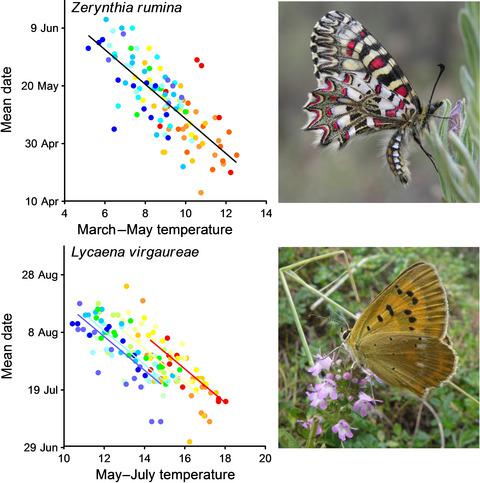当前位置:
X-MOL 学术
›
J. Anim. Ecol.
›
论文详情
Our official English website, www.x-mol.net, welcomes your
feedback! (Note: you will need to create a separate account there.)
Intra‐ and inter‐specific variation in the responses of insect phenology to climate
Journal of Animal Ecology ( IF 3.5 ) Pub Date : 2020-10-12 , DOI: 10.1111/1365-2656.13348 David Gutiérrez 1 , Robert J Wilson 2
Journal of Animal Ecology ( IF 3.5 ) Pub Date : 2020-10-12 , DOI: 10.1111/1365-2656.13348 David Gutiérrez 1 , Robert J Wilson 2
Affiliation

|
Phenological change is the most widely documented biological impact of climate change, but shows marked variation in magnitude among populations and species. Thus, quantifying the environmental factors and organismal differences driving this intra- and inter-specific variability in phenology is vital to understand and forecast the ecological consequences of climate change. Here, we test intra- and inter-specific differences for a set of butterfly species in the organismal sensitivity of flight phenology and its dependence on environmental factors, using as our model system an elevation gradient in a Mediterranean mountain range where temperature and relative humidity vary substantially over space and time. We use field-collected meteorological data, and butterfly counts for 20 univoltine species over 14 years, to test the relative effects on phenology of temperature and relative humidity, the sensitivity of phenology to spatial and temporal variation in temperature, and whether ecological traits account for inter-specific variation in sensitivity. For all species, temperature in the months immediately preceding adult emergence had the strongest relationship with phenology. All species appeared earlier in warmer years, with those flying earlier in the season showing the greatest sensitivity to annual (temporal) variation in temperature. However, only a minority of species showed evidence of plastic, space-for-time responses to temperature. Instead, most species showed strong evidence that phenology was more sensitive to temporal than spatial variation in temperature. Our results support the dominant influence of temperature on phenology, even in Mediterranean environments suffering summer drought. They also suggest that accurate forecasts of species' phenological shifts could require the isolation of spatial from temporal components of temperature variation, because the sensitivity of populations and species may differ across these two dimensions. The factors driving synchronisation of phenology over space merit particular research in the context of climate change, given their potential to expose populations simultaneously to environmental extremes.
中文翻译:

昆虫物候对气候响应的种内和种间变异
物候变化是气候变化的最广泛记录的生物影响,但在种群和物种之间显示出显着的差异。因此,量化环境因素和生物体差异驱动物候学的这种种内和种间变异对于理解和预测气候变化的生态后果至关重要。在这里,我们测试了一组蝴蝶在飞行物候的有机体敏感性及其对环境因素的依赖性方面的种内和种间差异,使用温度和相对湿度变化的地中海山脉的海拔梯度作为我们的模型系统大大超过空间和时间。我们使用现场收集的气象数据,以及 14 年来 20 种单性物种的蝴蝶数量,测试温度和相对湿度对物候的相对影响,物候对温度时空变化的敏感性,以及生态特征是否解释了敏感性的种间变化。对于所有物种,成虫出现前几个月的温度与物候的关系最强。所有物种都出现在较温暖的年份,而那些在季节较早飞行的物种对温度的年度(时间)变化最为敏感。然而,只有少数物种表现出对温度的塑性、时空反应的证据。相反,大多数物种显示出强有力的证据表明物候对温度的时间变化比空间变化更敏感。我们的结果支持温度对物候的主要影响,即使在遭受夏季干旱的地中海环境中。他们还表明,对物种物候变化的准确预测可能需要将温度变化的空间分量与时间分量隔离开来,因为种群和物种的敏感性可能在这两个维度上有所不同。在气候变化的背景下,驱动物候同步的因素值得特别研究,因为它们有可能使人口同时暴露于极端环境。
更新日期:2020-10-12
中文翻译:

昆虫物候对气候响应的种内和种间变异
物候变化是气候变化的最广泛记录的生物影响,但在种群和物种之间显示出显着的差异。因此,量化环境因素和生物体差异驱动物候学的这种种内和种间变异对于理解和预测气候变化的生态后果至关重要。在这里,我们测试了一组蝴蝶在飞行物候的有机体敏感性及其对环境因素的依赖性方面的种内和种间差异,使用温度和相对湿度变化的地中海山脉的海拔梯度作为我们的模型系统大大超过空间和时间。我们使用现场收集的气象数据,以及 14 年来 20 种单性物种的蝴蝶数量,测试温度和相对湿度对物候的相对影响,物候对温度时空变化的敏感性,以及生态特征是否解释了敏感性的种间变化。对于所有物种,成虫出现前几个月的温度与物候的关系最强。所有物种都出现在较温暖的年份,而那些在季节较早飞行的物种对温度的年度(时间)变化最为敏感。然而,只有少数物种表现出对温度的塑性、时空反应的证据。相反,大多数物种显示出强有力的证据表明物候对温度的时间变化比空间变化更敏感。我们的结果支持温度对物候的主要影响,即使在遭受夏季干旱的地中海环境中。他们还表明,对物种物候变化的准确预测可能需要将温度变化的空间分量与时间分量隔离开来,因为种群和物种的敏感性可能在这两个维度上有所不同。在气候变化的背景下,驱动物候同步的因素值得特别研究,因为它们有可能使人口同时暴露于极端环境。











































 京公网安备 11010802027423号
京公网安备 11010802027423号